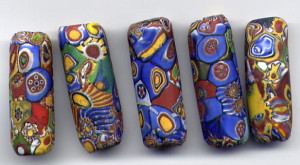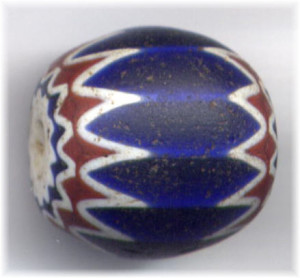“Venetian trade beads” (also referred to as “Murano beads”, or simply “trade beads”) is a collective term used to describe glass beads of varying design originally produced in Venice, Italy, between the 13th and 20th Centuries. They were intended as a basic form of currency, to be exchanged with tribal leaders for spices, furs, gold and slaves, as merchants sought out new avenues for trade in Africa.
Prior to the trade era, numerous glass-makers were known to be producing glass beads in the Rio Alto and Dorsudoro districts of the city on a commission-only basis. As overseas demand grew, the Maggior Consulio (Great Council) realized the great fire risk posed by the glass-making guilds to the city. In 1291, they decreed that all guilds had to be moved to Murano (hence the name), a series of islands in the Venetian Lagoon. Here, under the strict control of the Council, production flourished. Glass-makers developed innovative techniques, such as lampworking and Perle a Lume, to create some of the most ornate beads imaginable.
Distinguished by their striped patina, Chevron (or Rosetta) Beads were among the earliest known decorative beads to be produced in Murano. They are made by fusing rods of colored glass (known as “murrine”) around a single hollow cane, creating a layered rosetta, or star, around the central perforation. The oldest surviving examples date back to the 14th Century, and are red, white and blue in color. Chevron beads are aesthetically similar to 18th Century Venetian King Beads, however the latter are almost always biconical in shape.
Millefiori (meaning “thousand flower”) was the name given to a style of Venetian trade bead produced in the 18th Century. Characterized by beautiful floral mosaics, these decorative beads were highly coveted among African tribes in the 19th Century. They are made in a similar way to the earlier Chevrons, however, the canes are pulled thin whilst still hot to achieve variations in size.
References:
Trade Beads. Boone Trading.
Trade Beads. Wikipedia.
Millefiori. Wikipedia
History of Venetian Glassmaking. BigBeadLittleBead
Images


